|
|
|
COMMAND AIRCRAFT MARKINGS |
|
|
 |
|
Copyright - © Mark Karvon
1994-2008X |
|
An aircraft
designated for the commander of a unit is most
commonly called a "flagship". The dictionary
definition for naval term "flagship"
"the lead ship in a fleet of vessels " holds true in the
USAF for these aircraft as well. As an early Air Force tradition,
the use of command stripes, in one form on another, is still in use
today. As seen in this great piece of artwork "F-106
Delta Dart - 318th FIS "Green Dragons" by artist Mark Karvon
(which can be purchased at
www.markkarvon.com),
the fuselage bands found on F-106A 59-0004
are in the typical location used by F-106 units.
|
|
|
|
Boss Bird, Wing King
are common nicknames for aircraft assigned to a units Commander.
The aircraft in that position is truly considered a units "flagship"
a naval term that is defined as the "lead ship in a
fleet of vessels used by the commanding officer of a group of naval
ships". For many years, a typical method to designate a units
"flagship" was the use of command stripes. Since the early
history of the U.S. Army Air Corps, aircraft have been decorated with
these markings designating various command positions within combat unit.
|
|
|
|
In March on 1938,
General Headquarters of the Air Force issued Technical Order T.O. 07-1-1
mandating that all of its aircraft have Squadron Recognition Colors, an
Airplane Designator and, Command Recognition Stripes for the various
leadership positions of a unit.
|
|
|
|
After World War II
where the stripes were rarely used, in the first years after the war the command stripe made a comeback with USAF fighter units.
|
|
|
|
Using the colors the markings of the unit, one to four stripes painted
on the fuselages of selected aircraft for the following command
positions:
|
|
|
|
Four stripes - Air Division,
Wing, Group, Commander
|
|
Three stripes - Squadron
Commander
|
|
Two stripes - Director of
Operations
|
|
One stripe - Flight Commander
|
|
|
|
During
the mid 60's, the Air
Force aircraft began to fly combat missions Southeast Asia, and adopted
a tone down appearance for their tactical aircraft. A uniform green, tan
& gray camouflage began to replace the high visibility markings used
throughout the 50's and early 60's. With the removal of the high
visibility unit tail markings, the USAF created a distinctive tail code
system (using two letters) to identify the unit assignment of a
particular aircraft.
|
|
|
|
Along with these codes,
these aircraft would also carry a stripe (known as a tail stripe) across
the upper portion of the tail painted in a distinctive color for each
squadron within a Wing. To replace the command stripe on the fuselage of
command aircraft, many units would paint a tail stripes high on the tail
of the commanders aircraft for each assigned squadron. Most air defense
aircraft (F-4's, F-101's F-102's F-106's & T-33's)retained their
hi-visibility markings through the 1980's.
|
|
|
|
In the 1980's, units
would begin to add a unit designator (typically in place of the aircraft
serial number), as an additional means of identifying the "Boss Bird"
from a "line jet". Generally one aircraft per unit
is chosen to become a "Flagship" carrying the designation for a particular
organization. On these aircraft, the squadron or wing designation is
most commonly used, but some aircraft
wore the titles of Numbered Air Forces, Air Divisions, or maintenance
units.
|
|
|
|
|
|
COMMAND AIRCRAFT |
|
|
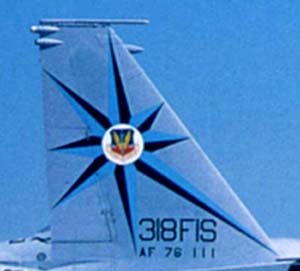 |
|
Similar to other units in the Air Force, the 318th FIS
designated various aircraft as the squadron "flagship". Below you will
find photos of the aircraft that served in that role.
|
|
|
|
|
|
F-94 STARFIRE |
|
|
|
GROUP COMMANDER |
|
|
|
F-94A S/N 49-2586 |
|
|
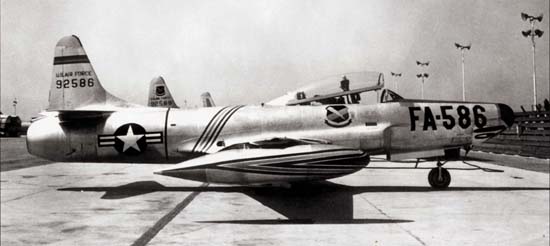 |
|
x |
|
Wearing four stripes
and on its wing tanks, F-94A 49-2586 was designated as the 325th Fighter
Group commanders aircraft.
|
|
|
|
|
|
SQUADRON COMMANDER |
|
|
|
F-94A S/N 49-2586 |
|
|
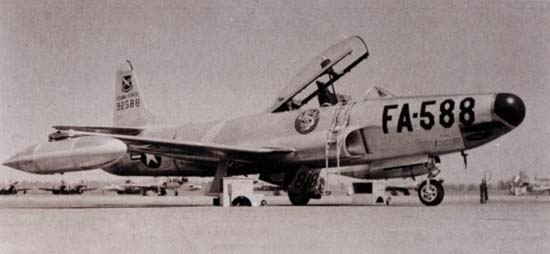 |
|
x |
|
The 318th FIS
Commanders F-94A 49-2588 wore the traditional three command
stripes, yellow in color.
|
|
|
|
|
|
DIRECTOR OF OPERATIONS |
|
|
|
F-94A S/N 49-2586 |
|
|
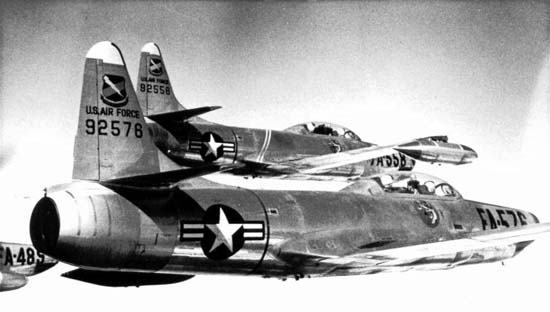 |
|
x |
|
Two fuselage bands
can be found on F-94 s/n 49-2558.
|
|
|
|
|
|
F-106 DELTA DART |
|
|
|
DIVISION COMMANDER |
|
|
|
F-106A S/N 59-0065 |
|
|
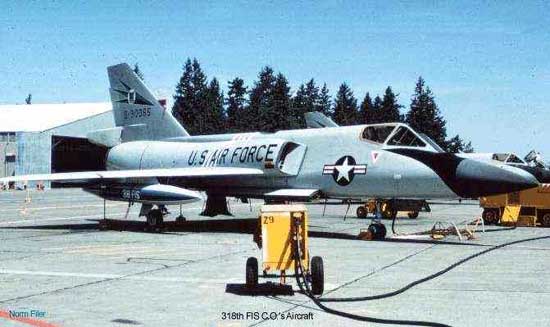 |
|
PHOTO BY NORM FILER |
|
Four
white stripes can be seen between the "S"
(in "U.S.") and
the "R" (in "AIR") of the U.S. Air Force marking on the fuselage of F-106A 59-065, pictured
in the late 60's early '70s.
|
|
|
|
|
|
SQUADRON COMMANDER |
|
|
|
F-106A S/N 59-0004 |
|
|
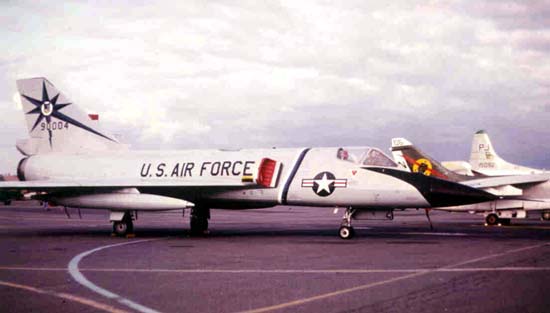 |
|
xPhoto
from Marty Isham Collection |
|
F-106A s/n 59-0004
wore (front to back) dark blue, light blue and white command stripes in
this 1978 photograph. The aircraft was destroyed in a crash on June 24,
1980.
|
|
|
|
F-106A S/N 59-0054 |
|
|
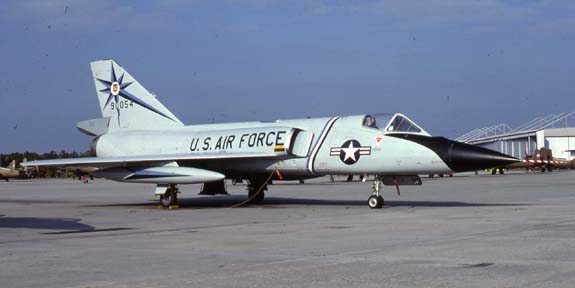 |
|
x |
|
After the crash of
F-106A s/n 59-0004 in 1980, F-106A s/n 59-0054 was next to wear the command stripes
of the 318th FIS, but the stripes were painted in a different order. The stripes were (front to
back) dark blue, white and light blue. The aircraft wore the scheme
until (aprox) late 1982.
|
|
|
|
|
|
DIRECTOR OF OPERATIONS |
|
|
|
F-106A S/N 59-0057 |
|
|
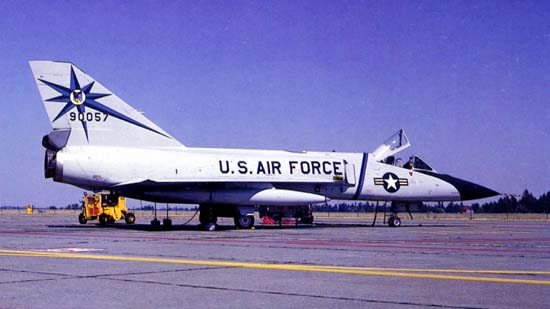 |
|
PICTURE FROM THE BOOK "FIGHTER INTERCEPTORS AMERICAS COLD WAR
DEFENDERS" |
|
Being assigned the
the 318th FIS "DO" in the late 70's, s/n 59-0057 wore two fuselage bands (front to back)
one light blue band and one dark blue.
|
|
|
|
|
|
FLIGHT LEADER |
|
|
|
F-106A S/N 59-0143 |
|
|
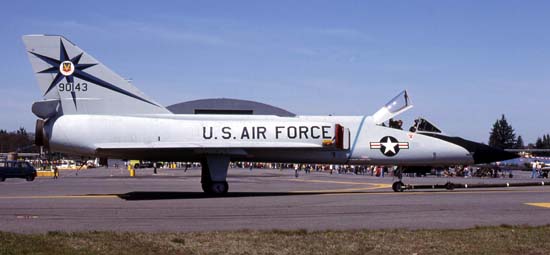 |
|
x |
|
A light blue band
can be seen on F-106A s/n 59-0143 in this 1980 photo.
|
|
|
|
|
|
|
|
|
|
F-15 EAGLE |
|
|
|
SQUADRON COMMANDER |
|
|
|
F-15A S/N 76-0008 |
|
|
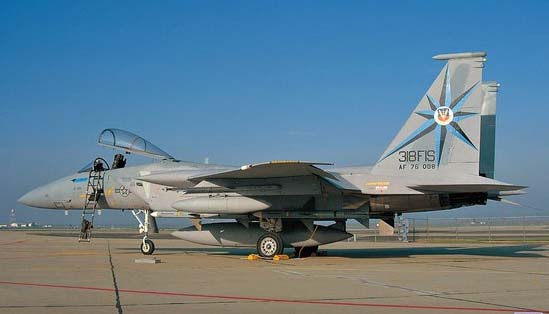 |
|
xx |
|
Armed with AIM-7s F-15A
s/n 76-0008 is pictured at Det 1 318th FIS in Castle AFB, CA in the late
1983 - early 1984 timeframe. The aircraft served as the squadron flagship until 1986.
|
|
|
|
|
|
F-15A S/N 76-0111 |
|
|
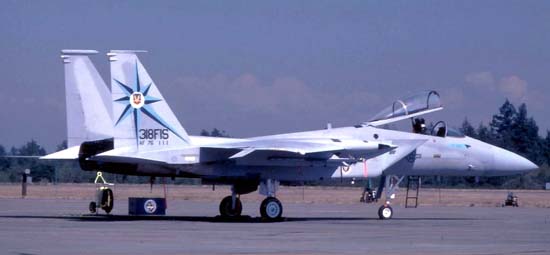 |
|
PHOTO
BY PAUL CARTER "PLANEPHOTOMAN" |
|
Nicknamed "Triple
Sticks" because of its serial number F-15A 76-0111 is pictured on the
McChord's "Echo" ramp on August 25, 1987. The aircraft suffered a hard
landing on November 15, 1986 after taking the role as the squadron "Boss
Bird" or
|
|
|
 |
|
|
|
After a order to
remove the "Starburst" tailflash, 76-0111 along with the squadrons other
F-15's replaced the trademarked design with the tactical tail code of
"TC". F-15A 76-0111 continued as the 318ths flagship until the
inactivation of the squadron in 1989.
|
|
|